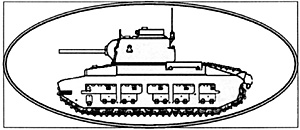 In 1939 France controlled a huge colonial empire
including most of North and West Africa, Madagascar, the
"Levant" (Syria and Lebanon), Indochina (Vietnam,
Cambodia and Laos) and numerous smaller dependencies.
France was a great power, with a large navy, air force, and
an army which many at the time considered the world's
best.
In 1939 France controlled a huge colonial empire
including most of North and West Africa, Madagascar, the
"Levant" (Syria and Lebanon), Indochina (Vietnam,
Cambodia and Laos) and numerous smaller dependencies.
France was a great power, with a large navy, air force, and
an army which many at the time considered the world's
best.
The vast majority of this force was concentrated in France itself, with significant portions in French North Africa: Morocco, Tunisia and Algeria. French mobilization was based on 21 Regions Militaires, with one, the 19th, in Algeria. The system was in many ways quite similar to the German Wehrkreise. Each Region Militaire would mobilize at least one corps. After mobilization the army could field 87 divisions: 61 of these were organized in France itself, 19 were North African, and 7 were Colonial. The last two require some explanation about the French Empire and the French armies.
North African divisions were raised (logically) in the French holdings in North Africa: Algeria, Tunisia and Morocco. These troops were referred to collectively as the Armee d'Afrique. Residents of Algeria were subject to the draft just as were residents of France. Algeria was considered an overseas department of France, at least by the French. Morocco and Tunisia were legally protectorates and the French theoretically relied on volunteers there.
The Colonial Army, La Coloniale, was a fourth service, with its own chief of staff like the Army, Air Force and Navy. La Coloniale was a force of all arms with its own armor, engineer, artillery, signals etc. Its troops came from all over the French Empire: Vietnam, Madagascar, Senegal, Guinea, Chad, Cameroon, Morocco and France. By May 1940 it fielded no less than 38 infantry and 27 artillery regiments. Originally part of the Navy, after 1900 it was independent. Its primary mission was defense of the Empire; French overseas possessions other than in North Africa were garrisoned almost exclusively by La Coloniale.
With the threat of war in Europe it was greatly expanded, especially its West African component and its best troops were concentrated in France. Colonial units had larger regular cadres than other units, and the Colonial Army was mainly volunteer. It also got the pick of draftees to fill out its ranks. For these and other reasons it was considered, even by the Foreign Legion, to be a cut above other French troops.
Doctrine
Just as the Germans had their Blitzkrieg, the French had a philosophy of war, Bataille Conduit, methodical battle. To reduce a complex issue to its basics, the French favored a tightly centralized and controlled, step-by-step style of fighting. After all, this was how the Allies ultimately won the First World War. In contrast to the German method of encouraging initiative down to the small unit level, the French military thought preferred rigid centralization and strict obedience.
Unfortunately for France this is precisely the type of combat which allowed the Germans to achieve the short, violent, mobile battle they needed to overcome their long-run disadvantages versus the Allies. The French High Command had failed to prepare for modern war, lacking the flexibility and responsiveness to deal with the unexpected.
The French Army in 1939
- Introduction and Doctrine
Infantry
Cavalry and Armor
Artillery and Anti-Aircraft
Fortifications and Bibliography
Back to Europa Number 29 Table of Contents
Back to Europa List of Issues
Back to MagWeb Master Magazine List
© Copyright 1993 by GR/D
This article appears in MagWeb.com (Magazine Web) on the Internet World Wide Web. Other articles from military history and related magazines are available at http://www.magweb.com